North Korea’s Newest Ballistic Missile: A Preliminary Assessment
On May 4, under the watchful eye of Kim Jong Un, North Korea launched a series of projectiles featuring two types of large-caliber, multiple launch rocket systems (MLRS) and a new short-range ballistic missile. A few days later, North Korea released photographs of tested projectiles, which provides a basis for preliminary evaluations. The 240 mm and 300 mm diameter MLRS systems are not new to North Korea, nor do they alter the country’s battlefield capabilities. The short-range ballistic missile, depending on its origins, may significantly enhance Pyongyang’s capacity to conduct strategic strikes against targets in South Korea.
Artillery Rockets
The 240 mm diameter rocket has been part of the DPRK’s arsenal for several decades. It has an estimated range of about 40 to 50 km and carries a relatively small warhead of about 45 kg. Photographs reveal that it relies on a smokeless, double-base solid fuel that is common to most battlefield rockets.
Figure 1. The 240 mm MLRS rockets powered by smokeless, double-base solid fuel. The rockets have a range of about 40 km.
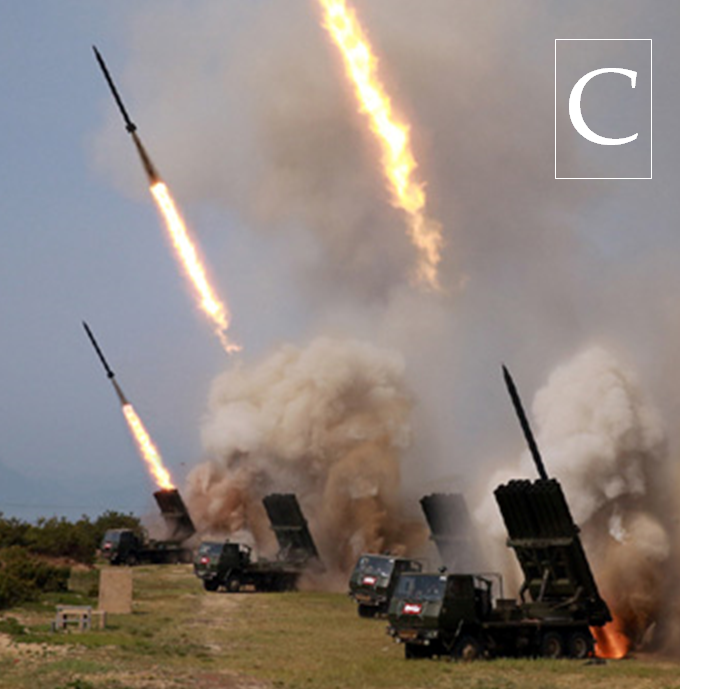
The larger 300 mm diameter rocket, designated by US intelligence as the KN-09, is a newer, more capable MLRS. The rocket was first tested in 2013, with subsequent tests performed in 2014 and 2016. It has a reported range of 190 to 200 km and carries a light, conventional warhead. It is powered by a standard composite-type solid fuel. Photographs show that the rocket is steered during flight by four small canard fins mounted at the rocket’s front end, near the warhead section, which provides for precision strikes if the guidance unit includes a satellite navigation receiver to update the inertial navigation components.
Figure 2. The 300 mm diameter KN-09 rocket.
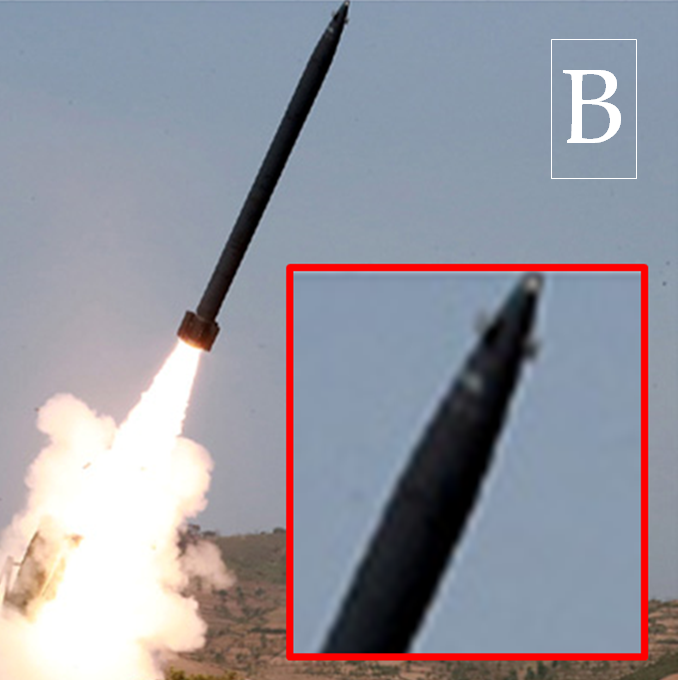
The KN-09 is fielded on a six-wheeled truck equipped with two launch pods, each having four launch tubes. Its primary mission is to strike rear echelon targets, some 50 to 100 km behind the primary line of battle.
The KN-09’s origins are unclear. It may be a modified version of a Chinese WS-1B rocket, or another similar system from the Weishi family of rockets originally developed by the China National Precision Machinery Corporation (CPMIEC).
The New Short-Range Missile
The new missile tested by North Korea outwardly appears to be a Russian Iskander (9M723, SS-26), short-range ballistic missile (SRBM) which has a range of about 280 km when carrying a 450-500 kg warhead. There are several versions of Iskander, including the Iskander-E which was specifically designed and produced for export. Moscow is permitted to export the Iskander-E because its range and payload characteristics fall below the performance thresholds established by the Missile Technology Control Regime (MTCR).[1]
Iskander flies on a flattened trajectory, never exceeding an altitude of about 50 km. The R-17 (Scud-B) ballistic missile, by comparison, reaches a peak elevation of 80 to 90 km when covering a ground distance of 280 to 300 km. At altitudes below 50 km the air is dense enough to facilitate aerodynamic steering using the four small fins mounted at the Iskander’s tail end. In other words, Iskander can alter its flight path after the boost phase, and over its entire trajectory. When aided by satellite-navigation, receivers such as GPS or GLONASS (Globalnaya Navigazionnaya Sputnikovaya Sistema), Iskander can make course corrections and reliably land within 20 to 50 meters of its designated target. Such accuracy allows Iskander to destroy targets dependably when armed with a conventional warhead, making it a very effective military weapon.
In-flight maneuverability, in addition to substantially enhancing accuracy, also complicates and compromises ballistic-missile defenses. Defenses can no longer precisely predict Iskander’s post-boost flight path, making it more difficult for the fire-control radar to calculate an anticipated interception point, without which the interceptor cannot be aimed with precision. Instead, the interceptor must fly to an approximated intercept point and rely on its kill-vehicle to make larger adjustments than would be otherwise needed as it makes a final approach to the target. The added unpredictability reduces intercept probabilities.
Finally, Iskander can exploit gaps in South Korean and American missile-defense coverage. While the exact numbers are secret, Patriot missile-defense interceptors are believed to have an engagement ceiling of about 40 km. The upper-tier or exo-atmospheric interceptors employed by THAAD and Aegis missile defenses have an engagement floor of roughly 50 km attitude. This creates a 10-km interceptor effectiveness seam at altitudes between 40 and 50 km. The seam almost perfectly coincides with Iskander’s flight path prior to its sharp dive toward ground-based target. Current missile defenses may struggle to intercept Iskander missiles reliably.
Did North Korea Flight Test an Iskander?
The origin of the short-range ballistic missile tested by North Korea is unknown. There are three possibilities: 1) North Korea imported Russian-made Iskander missiles; 2) the tested missile is an Iskander clone produced by another country and transferred to Pyongyang; or 3) North Korean engineers either acquired technical documentation for the Iskander, or otherwise copied the Iskander’s design and produced the missile indigenously, with or without foreign technical assistance.
Photographs of the missile look remarkably like those of a Russian-produced Iskander, suggesting that North Korea imported the missile either directly from Moscow, or through a third party. However, the tested missile is also very similar to two other known systems, the Hyunmoo-2 fielded by South Korea and the Ukrainian Grom (sometimes Hrim), which is reportedly under development. All four missiles appear to share the same external dimensions and features, with only minor differences in the shape of the nose cones. Iskander is known to be equipped with at least three different nose cones, so the variations across the four missiles may not be determinate.
Figure 3. Comparison of four similar missile types.
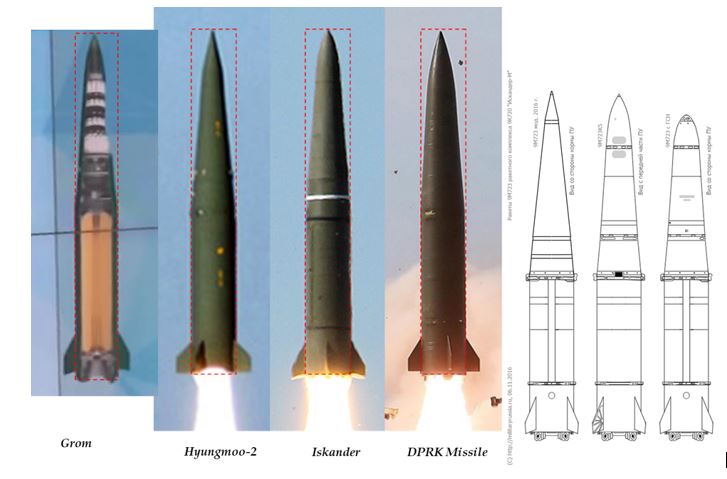
Procuring the Hyunmoo-2, which was reportedly designed and developed by South Korea with technical assistance from Russia, seems highly improbable for obvious reasons. Acquiring the Grom from Ukraine is distinctly possible, although the Ukrainian version of Iskander reportedly remains in early development. Nonetheless, this possibility cannot be dismissed, despite it being unlikely.
This leaves scenarios one and three as the more probable explanations. North Korea is already known to have produced prototypes for the Pukguksong-1 and -2 missiles, both of which are solid-fuel systems. It would not be too surprising if its engineers ventured to develop a smaller, shorter-range missile resembling Iskander. However, there are no reports of development activity for such a missile, casting some doubt on this explanation. Further, the first suggestion that North Korea was interested in a missile like Iskander was seen during a February 2018 military parade in Pyongyang, where mockups of a missile of similar size and shape were unveiled. The mockups, however, were quite crude, as were the transporter erector launchers (TELs) carrying them. Iskander is a very sophisticated missile, one that would require years of development and testing. The missile tested last week, if domestically designed and produced, even with extensive foreign assistance would be in an early development phase, years away from operational deployment, and years removed from being a precision-guided missile.
Figure 4. The mock-up missiles paraded in February 2018 featured cable ducts that extend along the warhead section.
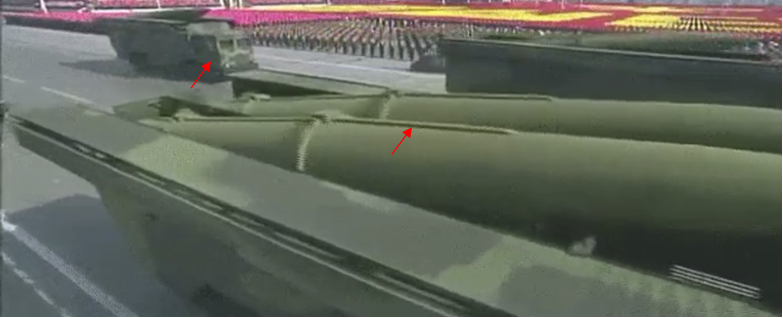
The more likely explanation relates to the direct import of Iskander from either Russia or a third party. Pictures from the test launch support this explanation. As shown in Figure 5, and highlighted originally by German missile-specialist Markus Schiller, the debris generated by the launch in North Korea is a virtual match of a launch of Iskander conducted by Russia. This coincidence is compelling and fully consistent with the importation of a Russian-produced Iskander. If North Korea did in fact import Iskanders from Russia, it has an existing capacity to deliver warheads to targets in South Korea with great precision, and an ability to penetrate existing missile defenses deployed in the South.
Figure 5. The Russian Iskander (left) sheds its two support bands in the same manner as was seen in last week’s North Korean launch (right). The red arrows point to the separated bands that broke in half during the launch process.
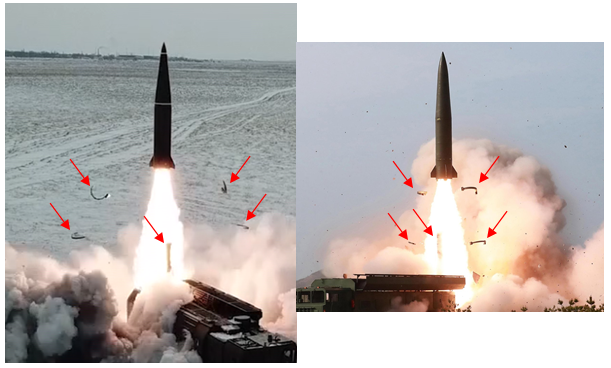
Conclusion
Regardless of the origins of North Korea’s newest short-range ballistic missile, its appearance and testing provide convincing evidence that Pyongyang continues to seek greater military and strategic capabilities. This is not surprising, as Pyongyang perceives itself to be under threat of aggression by the United States. Kim Jong Un very likely has other strategic weapons projects underway, whether foreign procurement efforts or indigenous development programs. If little progress is made in the negotiations between Washington and Pyongyang in the near to mid-term future, expect to see the unveiling of more, increasingly capable strategic weapons and capabilities.
- [1]
The MTCR is a voluntary export-control measure adopted by the world’s leading missile-producing countries in an attempt to impede the proliferation of ballistic and cruise missiles capable of delivering nuclear (or chemical and biological) warheads.
